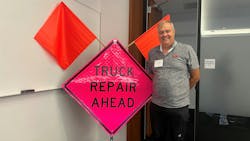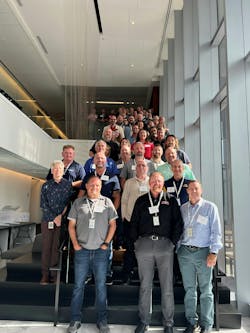Six years ago, the first Safety Leadership Summit brought together 21 employees from 14 commercial tire dealerships to share best practices and the latest in safety technology.
The dealer-born event has evolved beyond the commercial tire space and in 2025 grew to encompass more than 70 people from 38 tire dealerships, plus a handful of safety-focused suppliers.
This year, like all the others, safety leaders have brought concerns and problems from their tire dealerships and brainstormed with their peers to find solutions. Often, a worry in one tire dealership exists in another and sometimes it’s already been solved - or at least tended to - by yet another.
The leaders check any competitive positionings at the door and resolve to help one another do what they can to keep all of their tire technicians safe.
Here’s a look at seven takeaways from the 2025 summit, where MTD once again had an exclusive seat. These are presented in no particular order, except that they have broad applicability across the tire industry.
- TPMS policy. Just like many tire dealerships have created an in-house rule of whether they install tires bought somewhere else, Brian Rigney, president of Dill Air Controls, suggests tire dealers create a policy about tire pressure monitoring system (TPMS) installations.
Rigney says there’s no across-the-board standard for sensors. “There’s no ‘Here’s the minimum bar it must meet.’” As a result, there are some inexpensive and unreliable options that might be attractive to consumers.
Rigney says, “What we’ve seen recently is people buy four sensors on Amazon (and) they’ll walk into your store and say, ‘Hey can you install these four sensors?’ You didn’t test them and you don’t know where they came from. If you install them, are you now responsible for their performance? What we can tell you is there’s a lot of deficiencies out there as far as meeting what was in the TREAD Act.”
He’s monitored and tested sensors that lift up inside the tire when a vehicle is driven at high speeds. The valve also lifts up and the tire leaks air. But then the sensor usually falls back into place, so soapy water on the valve and tire won’t help find the leak. “We call those 'ghost leaks.'" Rigney says he’s seen sensors that don’t accurately read and detect the tire’s air pressure, which means they also don’t indicate when the pressure has dropped below the required threshold. Other sensors don’t immediately report a significant drop in pressure as they should.
“When we do competitive analysis of these inexpensive sensors, we try to show the risks involved. Then you may come up with a policy that ‘We will not install outside sensors. We will only install sensors we’ve procured and tested.’
“As an industry. we have to develop standards (of) what’s acceptable and what’s not because these are safety systems. These are literally designed to prevent accidents (and) to prevent tire failures.”
Check out our exclusive photos of the 2025 Safety Leadership Summit!
- The rules of C-metric tires. In the eyes of the Occupational Safety and Health Administration (OSHA), C-metric tires often found on cargo vans are commercial truck tires. OSHA made that ruling last year after the Tire Industry Association (TIA) sought clarifying guidance on whether those tires, which have similarities to light truck tires, can in fact be handled as marked LT tires. OSHA said no. Russ Devens, director of safety and risk management at Wilkes-Barre, Pa.-based McCarthy Tire Service Co. Inc., said the ruling means the tires must be inflated either in a cage or while mounted on a vehicle using a stand-off inflator.
“I went out and had to buy about 150 stand-off inflators for our retail guys,” says Devens. "Make sure those C-metric tires are treated as commercial tires.” (TIA issued a safety and training bulletin in late 2024 with guidance on this issue.)
- Overnight battery and tool charging. Several tire dealerships represented at the summit already have rules on the books about battery charging. Patricia Otterbach, safety manager at Deland, Fla.-based Boulevard Tire Center, says the company has a simple policy. "Everything has to be unplugged when they leave the building. (They) can’t leave anything plugged in and charging overnight.”
The issue is when batteries used in tools like impact guns become cracked or damaged. Devens says that "we know mechanics use batteries … as hammers and they crack the battery and then put the battery in the charger overnight and it catches fire.”
Devens says he can see extending that policy to roadside service trucks and other company vehicles, too, as new trucks are coming outfitted with an alternating current socket. “Our road techs are using battery-powered impact guns and things like that. If they’ve got the AC plugs in the trucks, (they) are probably going to start plugging in to charge batteries. You don’t want to burn up a truck.”
- Common injuries. A poll of the room didn’t show a single consensus, but dealers had a few notes to share about employee injuries. Josephine Foley, manager of safety and fleet at Sullivan Tire Co. Inc., which is based in Norwell, Mass., says her dealership "as seen a huge increase in hand lacerations.” She says she’s regularly reminding teammates to clean their cuts, because there have been cases of lacerations leading to swollen hands and infections because they weren’t cared for properly on the first day.
At Boulevard Tire, Otterbach says training for new hires includes training on proper personal protective equipment. The company is also teaching proper lifting techniques every few months during new hire training and sending reminders on those techniques to employees every few months. She says Boulevard has seen “a downturn in back injuries.”
Sarah Mason, safety manager at Edmonton, Alberta-based Fountain Tire, says the dealership has studied its injury data and learned that “65% of our injuries were occurring (with) people with under one year of service.” Of those, 30% were among employees with less than three months of service and still under probation.
Mason says Fountain Tire spent a year beefing up its training for new hires and adding more competency assessments. The dealership has added more pictures and visuals to show safe work practices. She says Fountain Tire worked with its gloves provider and put glove application charts up around shops to show “use this glove when you’re doing this task.” Mason says the company’s new hire injuries dropped by 10% this year.
- Unusual retention benefits. Tire dealerships are always working to retain good workers, and Chase Cavanaugh, vice president of operations at Meridian, Idaho-based Commercial Tire Inc., says his company realized it had some locations with no staff turnover. So Commercial Tire started polling employees at those locations. “Two of our most popular locations have great snack drawers," the dealership learned.
He says older generations were swayed only by wages, but that’s not the case with younger workers. “You have to be competitive with their pay,” he says, but employees cited the snack drawers and break room activities as perks they enjoyed. Managers of the zero-turnover stores put an Xbox in the break room.
Cavanaugh believes young workers — especially those whose school years were disrupted by COVID-19 shutdowns — are looking to make social connections with their coworkers where “they can feel a part of something.”
Two years ago Commercial Tire’s turnover rate was 61%. Cavanaugh says it’s dropped to 41%.
- Roadside safety. A Best-One Tire Group commercial roadside tire technician was injured in June after he was hit by a tractor-trailer driver in the middle of the night along Interstate 75. The technician survived, but was seriously injured and lost a leg in the accident.
Norm Peterson, safety and training facilitator for Best-One Tire Group, says Best-One is working to outfit its service trucks with reflective signs that technicians can place on the roadside or at any work site to alert motorists. Peterson says Best-One ordered more than 200 of the signs this fall.
- OSHA budget cuts. Steve Hawkins previously managed Tennessee’s OSHA as part of his role as deputy commissioner of the Tennessee Department of Labor and Workforce Development. He’s now the chief operating officer of FDR Safety LLC. At the summit. he shared a glimpse of what the federal government’s fiscal 2026 budget means for OSHA - and for OSHA inspections.
Hawkins says the proposed budget includes about $50 million less for OSHA in fiscal 2026 compared to fiscal 2025. The cuts include the elimination of the equivalent of 223 full-time staff. Hawkins says with fewer staff, the agency would be capable of about 10,000 fewer inspections — a 30% reduction.
About the Author
Joy Kopcha
Managing Editor
Joy Kopcha joined Modern Tire Dealer and Auto Service Professional as senior editor in 2014 after working as a newspaper reporter for a dozen years in Kansas, Indiana and Pennsylvania. She was named managing editor of MTD and ASP in 2022, and took on that same role with Motor Age in 2024.
She is an award-winning journalist, including in 2023 when she was named a Jesse H. Neal Awards Finalist.
Don't miss any of her articles. Sign up for MTD's newsletters.




